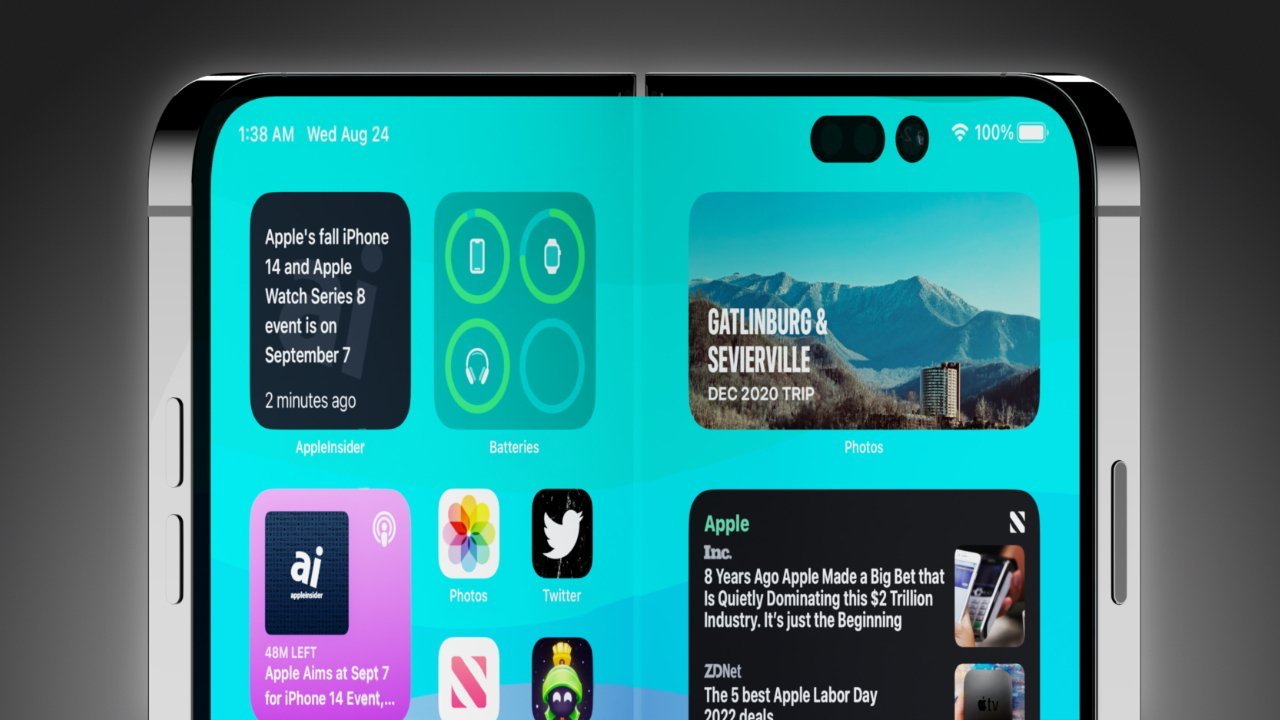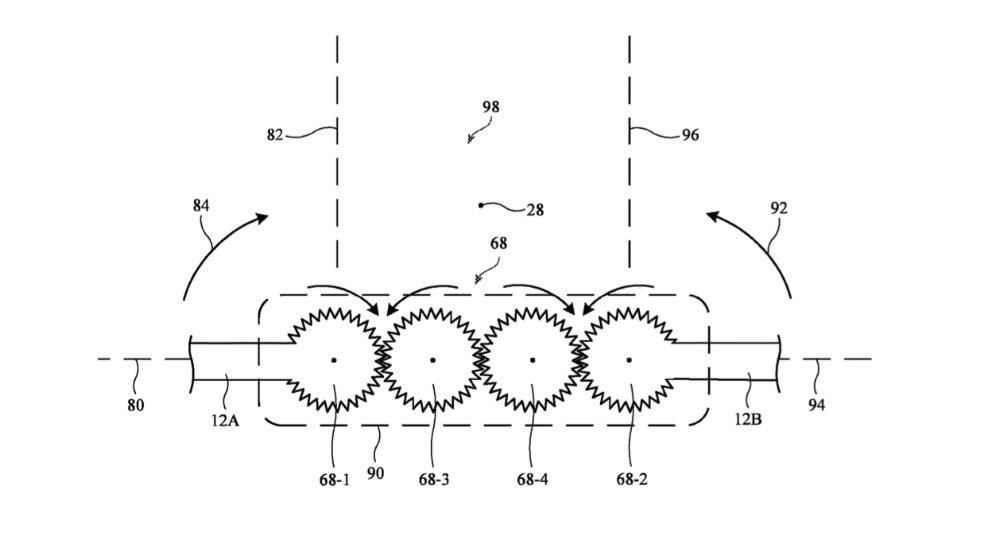Apple continues to evolve the hinge it may use on a folding iPhone
A newly-granted patent shows Apple has evolved its previous hinge designs, and is now describing foldable iPhone displays with far more intricate gearing.

A potential iPhone fold using a hinged display mechanism
When a folding iPhone, iPad, or even MacBook Pro is eventually launched, its fold hinge is likely to look typically smooth and simple. On the inside, however, it now looks as if Apple is at least favoring a design with an interlocking mesh of gearing.
Previous design drawings have shown at most three to four small cogs revolving around a single larger one. The new patent, entitled "Hinges for Folding Display Devices," includes designs with four pairs of seemingly small cogs, worked into a complex assembly of six static parts.

The latest design appears more complex than previous ones
"A foldable display device may have housing portions coupled by a hinge," says Apple. "The hinge may have a series of interconnected links... the links may be formed from interdigitated fingers in a friction clutch."
Alongside gears or cogs that allow for movement, Apple also describe pins that keep the apparatus travelling along set directions.
"The fingers or other portions of the links may be provided with crescent-shaped slots that receive pins," continues the patent. "During folding of the device, the pins may slide along the crescent-shaped slots, thereby ensuring that adjacent links rotate relative to each other about a rotation axis that lies outside of the hinge and within a flexible display panel."

One design shows multiple interlocking gear cogs
A separate sketch shows a row of four directly interlocking cogs, while others look to describe gears within different rigid elements.
"Links may also be formed from link members with curved mating bearing surfaces that slide relative to each other as adjacent links are rotated relative to each other," says Apple. "A housing rotation synchronization mechanism may be formed using a set of gears that extends between the first and second housing portions."
All of this suggests that Apple is moving away from one or more large hinge mechanisms, to a system that leverages many smaller gears. The newly-granted patent appears to be more complex and involved than earlier ones.
It's possible that Apple may be pursuing more than one design for hinges, however. Previous patents and patent applications have appeared to clearly be for iPhones or iPads, but this one specifically describes a wider range of devices, going from large to small.
"[The device] may be a cellular telephone, tablet computer, laptop computer, wristwatch device or other wearable device, a television, a stand-alone computer display or other monitor, a computer display with an embedded computer (e.g., a desktop computer)," it says, "[or] a system embedded in a vehicle, kiosk, or other embedded electronic device, a media player, or other electronic equipment."
Patents are always written to encompass as wide a range of possible applications of their technology, however. Also, while the new design appears to be a development of the previous ones, it could also be that Apple is still researching both.
The patent is credited to 10 inventors, including Bradley J Hamel, whose previous work includes another granted patent about friction hinges. There's also Kevin M. Robinson, previously listed on a patent application regarding a hinge mechanism, probably for the MacBook Pro.
Apple has long been reported to be working on an iPhone Fold. More recently, however, there have been claims that it will instead concentrate on folding iPads and the MacBook Pro.
Read on AppleInsider

Comments
Can you detail the scenario in which you would get a folding phone? I can't see a personal need for one and I don't think most people will want that. What I can envision is a use of the same, bendable OLED display tech that's that allow for a large variety of contoured surfaces, like the dashboard of a automobile, and eventually a scrolling display so one can have a large display when needed but have it to out of the way when not needed. I think they used something like that in the movie Mission to Mars.
And I disagree about durability. The displays can't too close together or they risk breaking the OLED display if something minute is caught between them when closing, and as far as I know they can't use any of Corning's alkali-aluminosilicate sheet glass-based Gorilla Glass products which means it's back to the soft plastics that were everywhere pre-iPhone, which makes it easier to damage the OLED substrate.
Why?
But the appetite for larger display is not going to go away anytime soon. So the next logical step in evolution of smartphones is - foldable form factor. It is not rocket science as Apple hardcore fans in this forum make it out to be. Just because Apple has not launched a foldable phone yet - does NOT mean that it is not useful or practical. It is only a matter of time that Apple will launch a foldable phone (once they are ready).
You can already buy a foldable phone in virtually all the major smartphone markets.
My brother's entire family switched to folding phones last year. My other brother got a Samsung Fold too.
No problems on any level and they all love the phones.
It is rumored that Huawei will release its latest model this month at (or around) MWC and some rumors say it is thinner when folded than a current iPhone. The previous generation was as thin as an iPhone in a case.
The move to mainstream is underway IMO. Two years could be a reasonable stab and if rumours play out, Apple may have its own foldable by then.
There will have to be a paradigm shift in how we use smartphones to warrant their use. Will a double thickness smartphone that can be a double-sized smartphone display as-needed but still a very small tablet become the norm? I don't see it, but, again, I'd like to hear the scenario in which that will occur. Convince me.
A Motorola Razor was foldable, small and light.
Unlike a Razor there will be a battery on both halves which won't last as long b/c they will be smaller to make room for the folding mechanism.
Once Apple released the retina displays and increased the size of the iPhone 4 to the current size. I was able to drop down to the normal iPhone b/c I could finally read the display w/o cheaters. Same for the Apple Watch Ultra, it's the perfect size plus it's light and the battery lasts for days but perhaps they should make it fold open. LOL.
This is a solution for a problem that doesn't exist and referencing Samsung does not strengthen anyone's argument.
Premium laptops have had equally good hinges for years now too.
Folding phone hinges have been excellent too and performed perfectly.
There are a few different designs which have different goals but progress has been amazing with Honor recently getting moving parts down to four but the overall complexity is clear from the teardowns. They are supremely well engineered and make good use of premium materials.
Not mainstream, and sales in 2022 were only 13.5 M units, a big jump form 2021 at 8.1M, but a rounding error in the scheme of things. I doubt that Apple users would trade their current iPhones for a decidedly less durable form factor, and I doubt that Android users will either, but obviously some have and more will.
you keep harping on “bigger screen” is better, but why? Is not an iPhone pro max big enough? What use case requires a larger screen that could not be done by switching to an iPad or laptop or desktop? The one use case I can think of is maybe accessibility for visually impaired, but is the max big enough for that?
I mean sure, if they could fit a bigger screen in an iPhone mini without increasing its length, width, or height in any configuration, I may consider it (eg, holographic projection, or via AR/VR/MR headset), but it would still have to be usable from one hand in my opinion.
He did that for good reason. There are different angles to mainstream. Just being available in most major markets and freely available as a purchase option can mean mainstream too.
Expect big jumps in unit sales as prices edge downwards.
Folding phones, especially 'flip' phones are now below $1,000 in China.
Most folding phones were only released at scale in China with Samsung and Huawei being practically the only manufacturers rolling out models worldwide.
That changed late last year and now more folding phones are available worldwide with Honor and OPPO putting out class leading devices and at aggressive price points.
In two years, if rumors prove true, Apple could be in the folding fold.
Depending on your hand size one handed use is perfectly doable on the folded phone.
As for bigger is better, that is always the case for when size is a befitting factor. There is an upper limit of course when size detracts from being useful but viewing content on a larger screen and modifying content on a larger screen both increase usability.
Even for silly things like moving the playhead around on video players. Larger screens allow for more interface elements to be viewed at one time. Opening multiple apps (one on top of the other or side by side) is much better.
My wife and anybody with poor eyesight will benefit from a larger screen even if it is basically a regular screen ratio with enlarged interface elements.
My wife has everything set pretty largish (but not to the max) on her iPhone and it's ugly to see how the system whacks the interface out of sync and usability actually goes down.
Honor Vs
https://www.techradar.com/reviews/honor-magic-vs
We use phones because they are always with us, relatively light and compact and available at all price points.
Given that situation and the necessary compromises, a folding phone opens up more usability benefits by simply doubling the screen size while remaining sufficiently compact when folded.
I can open and view apps onscreen on my phone (in split screen or floating mode). It works very well and I use it all the time. It's usable but a bigger screen would make the experience much, much better.
A 15 inch laptop would be even better but I would lose all the portability advantages of a phone and depend on earbuds. I can't hold a laptop to my ear.
But also, do you need to tote a laptop everywhere? Maybe your office is a coffee shop. But going to the grocery store, do you need to take a laptop with you to edit a video? Are you going to edit a video on your phone while at the store? I’d say maybe, if your job depended on it. But I’d argue 99 times out of a 100, that’s an exceptional case. Tote your laptop with you in whatever bag makes most sense to you if you’re going to need it, otherwise leave it behind.